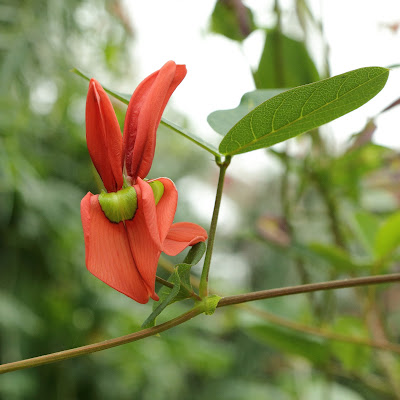Plant of the day is: Dietes robinsoniana or wedding lily
Definitely a looker of a flower. Not actually one of the showiest of the genus (in my opinion), but I've got a few seedlings up so they're special to me. It's been awhile since I gave a slot to a monocot, so ready or not...I'm terrible with rhymes.
Photo Credit: Quartl (CC BY-SA 3.0)
Definitely a looker of a flower. Not actually one of the showiest of the genus (in my opinion), but I've got a few seedlings up so they're special to me. It's been awhile since I gave a slot to a monocot, so ready or not...I'm terrible with rhymes.
Di - Greek - meaning two
Etes - Greek - meaning affinities
Taxonomy, etc: Again, another very small genus of just 7 species. Formerly placed in the Moraea genus (I see the resemblance for sure) BUT because they are rhizomatous ...new genus. Moraea grow from corms. Like Moraea however, they have six free tepals that are not joined into a tube at the base (like an Iris would be). Most species are found in southern or central Africa but have been very successful in naturalizing many different areas around the world including some already threatened habitats like Mauritius, Hawaii, and Jamaica. Oh, it's in the Iridaceae family, if I didn't mention that. Named after the Greek goddess Iris, of course, who carried messages from Olympus to earth along a rainbow which Linnaeus saw in the petals of many species. Named after Sir Hercules Robinson by the way.
Photocredit: http://Gardenology.org (CC BY-SA 3.0)
Notice the label at the bottom that helps highlight just how large this foliage is. Gives some of our Yucca a good run for their money.
Description: Perennial monocot growing up to 1.5m high with a thick creeping rhizome and blue-green Iris-like leaves. Leaves are linear about 100cm long and 5cm wide and a prominent midrib. Flowers are white, fragrant, and up to 4 in in diameter. Petals are ...3 actually, only 3 true petals. Flowers have neat yellow nectar guides. Each flower is similar to a daylily in that it is only open for one day.
Photo is a little dark but you get the idea how tall the scapes are compared to the foliage.
Habitat/culture: Originally endemic to Lorde Howe Island. This was a new one for me. Found between New Zealand and Australia in a very small island group of about 28 island, islets, and rocks. It wasn't actually discovered until 1788, which is notably late in the discovering of land thing. Discovered by Lieutenant Henry Lidgbird Ball, commander of the Armed Tender HMS Supply on it's way from Botany Bay. It was actually a whaling outpost for some time :(. Permanently settled in 1834. Now the island exports kentia palms and is a phenomenal diverse and relatively unspoiled habitat with many endemic species. Truly one of the few places on earth we haven't trashed. About 70 percent of the island is protected by the Lord Howe Island Act of 1981 and the surrounding waters are also designated an island marine park. Awesome stuff. Boasts the worlds southernmost barrier coral reef. I'm always fascinated by these tiny island and spits of land that are rarely taught and/or heard of. Plant of the day will likely feature habitats and plants like this for awhile sometime in the future. On the island itself, D. robinsoniana is found in the forest margins and is somewhat uncommon. Prefers well-drained moist soils in sun to part shade. This species definitely prefers moist, nutrient rich soils, but other member of the genus are drought tolerant but respond well to additional water (put on a bit more growth). Not hardy or frost tolerant, don't even think it, this is a tropical species. Also, these can take years and years and years to flower. Many botanical gardens have waited many a year for these to flower. I expect it will be a long time before I see them, here is hoping though. Something to stick around for :).
Propagation: Vegetatively by dividing rhizome stuffs, pretty standard stuff there. From seed, also quite easy. I sowed seed in a standard potting mix in a small 4" pot and placed on mist until I saw the first seedling popping up. Removed from mist and several more seedlings popped up. Will pot up into larger containers when they get a bit larger.




















